Heterogeneity in α-synuclein fibril activity correlates to disease phenotypes in Lewy body dementia
- PMID: 33641009
- PMCID: PMC8055043
- DOI: 10.1007/s00401-021-02288-1
Heterogeneity in α-synuclein fibril activity correlates to disease phenotypes in Lewy body dementia
Abstract
α-Synuclein aggregation underlies pathological changes in Lewy body dementia. Recent studies highlight structural variabilities associated with α-synuclein aggregates in patient populations. Here, we develop a quantitative real-time quaking-induced conversion (qRT-QuIC) assay to measure permissive α-synuclein fibril-templating activity in tissues and cerebrospinal fluid (CSF). The assay is anchored through reference panels of stabilized ultra-short fibril particles. In humanized α-synuclein transgenic mice, qRT-QuIC identifies differential levels of fibril activity across the brain months before the deposition of phosphorylated α-synuclein in susceptible neurons. α-Synuclein fibril activity in cortical brain extracts from dementia with Lewy bodies (DLB) correlates with activity in matched ventricular CSF. Elevated α-synuclein fibril activity in CSF corresponds to reduced survival in DLB. α-Synuclein fibril particles amplified from cases with high fibril activity show superior templating in the formation of new inclusions in neurons relative to the same number of fibril particles amplified from DLB cases with low fibril activity. Our results highlight a previously unknown broad heterogeneity of fibril-templating activities in DLB that may contribute to disease phenotypes. We predict that quantitative assessments of fibril activities in CSF that correlate to fibril activities in brain tissue will help stratify patient populations as well as measure therapeutic responses to facilitate the development of α-synuclein-targeted therapeutics.
Keywords: Aggregation; Biomarker; Neurodegeneration; Parkinson’s disease; Prion; SNCA.
Figures
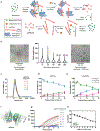
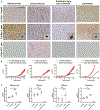
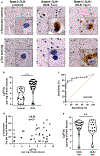

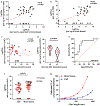
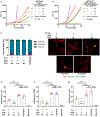

Similar articles
-
Ultrasensitive Detection of Aggregated α-Synuclein in Glial Cells, Human Cerebrospinal Fluid, and Brain Tissue Using the RT-QuIC Assay: New High-Throughput Neuroimmune Biomarker Assay for Parkinsonian Disorders.J Neuroimmune Pharmacol. 2019 Sep;14(3):423-435. doi: 10.1007/s11481-019-09835-4. Epub 2019 Jan 31. J Neuroimmune Pharmacol. 2019. PMID: 30706414 Free PMC article.
-
Prion-Like Seeding of Misfolded α-Synuclein in the Brains of Dementia with Lewy Body Patients in RT-QUIC.Mol Neurobiol. 2018 May;55(5):3916-3930. doi: 10.1007/s12035-017-0624-1. Epub 2017 May 26. Mol Neurobiol. 2018. PMID: 28550528 Free PMC article.
-
Clinical and biochemical correlates of insoluble alpha-synuclein in dementia with Lewy bodies.Acta Neuropathol. 2006 Feb;111(2):101-8. doi: 10.1007/s00401-005-0027-7. Epub 2006 Feb 16. Acta Neuropathol. 2006. PMID: 16482476
-
Pathophysiology of synuclein aggregation in Lewy body disease.Mech Ageing Dev. 2006 Feb;127(2):188-202. doi: 10.1016/j.mad.2005.09.014. Epub 2005 Nov 16. Mech Ageing Dev. 2006. PMID: 16297436 Review.
-
[Real-time Quaking-induced Conversion Analysis of Prion-like Seeding Activity of Pathological α-Synuclein].Yakugaku Zasshi. 2019;139(7):999-1005. doi: 10.1248/yakushi.18-00165-3. Yakugaku Zasshi. 2019. PMID: 31257259 Review. Japanese.
Cited by
-
Proteolytic α-Synuclein Cleavage in Health and Disease.Int J Mol Sci. 2021 May 21;22(11):5450. doi: 10.3390/ijms22115450. Int J Mol Sci. 2021. PMID: 34064208 Free PMC article. Review.
-
Early-Life Exposure to Commercial Formulation Containing Deltamethrin and Cypermethrin Insecticides Impacts Redox System and Induces Unexpected Regional Effects in Rat Offspring Brain.Antioxidants (Basel). 2023 May 5;12(5):1047. doi: 10.3390/antiox12051047. Antioxidants (Basel). 2023. PMID: 37237913 Free PMC article.
-
Ultrastructures of α-Synuclein Filaments in Synucleinopathy Brains and Experimental Models.J Mov Disord. 2024 Jan;17(1):15-29. doi: 10.14802/jmd.23213. Epub 2023 Nov 22. J Mov Disord. 2024. PMID: 37990381 Free PMC article.
-
Anionic nanoplastic contaminants promote Parkinson's disease-associated α-synuclein aggregation.Sci Adv. 2023 Nov 15;9(46):eadi8716. doi: 10.1126/sciadv.adi8716. Epub 2023 Nov 17. Sci Adv. 2023. PMID: 37976362 Free PMC article.
-
α-Synuclein molecular behavior and nigral proteomic profiling distinguish subtypes of Lewy body disorders.Acta Neuropathol. 2022 Aug;144(2):167-185. doi: 10.1007/s00401-022-02453-0. Epub 2022 Jun 24. Acta Neuropathol. 2022. PMID: 35748929
References
Publication types
MeSH terms
Substances
Grants and funding
LinkOut - more resources
Full Text Sources
Other Literature Sources
Medical
Miscellaneous

